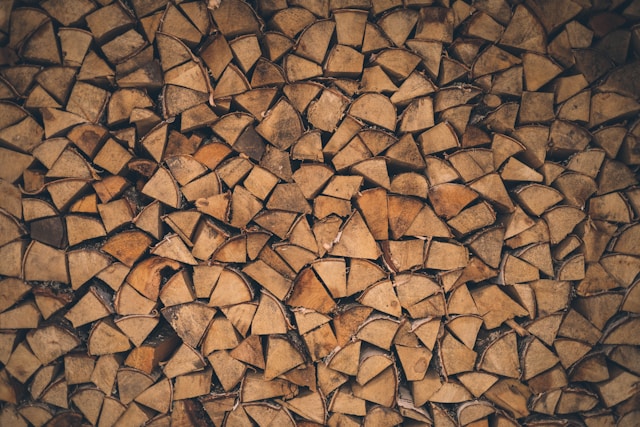When it comes to firewood, whether for a cosy indoor fireplace, a wood-burning stove, or an outdoor fire pit, choosing the right type can significantly impact the quality of your fire. Among the most popular options are seasoned firewood and kiln-dried firewood. While both have their advantages, understanding their characteristics will guide you to the perfect choice for your fire.
What Is Seasoned Firewood?
Seasoned firewood refers to wood that has been naturally dried over time to reduce its moisture content. This process involves cutting and splitting the wood, then stacking it in a well-ventilated area for several months, or even up to two years, depending on the wood type.
Key Characteristics of Seasoned Firewood
- Moisture Content: Typically ranges between 20% and 30%, although this depends on how long it has been dried.
- Drying Process: This relies on natural air circulation, which requires time and the right environmental conditions.
- Appearance: Seasoned firewood often has cracks on the ends and a lighter colour than freshly cut logs.
- Sound: When struck together, seasoned logs produce a sharp, hollow sound, indicating dryness.
What Is Kiln-Dried Firewood?
Kiln-dried firewood undergoes an accelerated drying process in a controlled environment. The wood is placed in a kiln—a specialised oven—and heated to remove moisture. Depending on the manufacturer and duration of drying, this process can reduce the wood’s moisture content to as low as 10% to 20%.
Characteristics of Kiln-Dried Firewood
- Moisture Content: Lower than seasoned wood, usually between 10% and 20%.
- Drying Process: A rapid and controlled drying method, taking days or weeks rather than months.
- Appearance: Kiln-dried logs are clean, often free from mould or pests, and have a consistent colour.
- Sound: Produces an even sharper and more hollow sound than seasoned wood when struck together.
Differences Between Seasoned and Kiln-Dried Firewood
- Drying Time
- Seasoned Firewood: Requires patience, as natural drying can take several months to a couple of years.
- Kiln-Dried Firewood: A quicker solution, typically taking a few days to weeks to achieve a usable state.
- Moisture Content
- Seasoned Firewood: Higher moisture content means it may not burn as efficiently and can produce more smoke.
- Kiln-Dried Firewood: Low moisture levels result in a hotter, cleaner burn with minimal smoke.
- Cost
- Seasoned Firewood: Generally more affordable, as the drying process does not require specialised equipment.
- Kiln-Dried Firewood: Costs more due to the energy and resources involved in the kiln-drying process.
- Quality and Performance
- Seasoned Firewood: Offers good performance but may require additional time to dry further if not properly seasoned.
- Kiln-Dried Firewood: Ready to use immediately, with consistent performance and reduced risk of creosote buildup in chimneys.
- Storage and Longevity
- Seasoned Firewood: May be prone to mould, pests, and decay if not stored correctly.
- Kiln-Dried Firewood: More resistant to pests and fungi, making it easier to store for longer periods.
Pros and Cons of Seasoned Firewood
Pros:
- More affordable.
- It can be dried at home, offering greater control.
- Readily available.
Cons:
- Requires extended drying time.
- Inconsistent quality due to varying drying conditions.
- Higher smoke production due to moisture.
Pros and Cons of Kiln-Dried Firewood
Pros:
- Low moisture content ensures efficient burning.
- Ready to use immediately.
- Cleaner, with no mould or pests.
Cons:
- Higher cost.
- It may not be as widely available in all regions.
Which Type Should You Choose?
The choice between seasoned and kiln-dried firewood largely depends on your needs, budget, and intended use.
- Seasoned Firewood: Ideal for those with the time to plan and who don’t mind the occasional variability in performance.
- Kiln-Dried Firewood: Perfect for those who want convenience, a hotter and cleaner burn, and are willing to pay a premium for quality.
Tips for Proper Firewood Storage
Regardless of the firewood type, proper storage is crucial to maintaining its quality.
- Stack firewood off the ground using a firewood rack.
- Ensure adequate airflow between logs by leaving gaps in the stack.
- Cover the top of the pile with a tarp to keep it dry, but leave the sides open for ventilation.
- Store firewood in a sheltered area away from moisture and pests.
Final Thoughts
Both seasoned and kiln-dried firewood have unique benefits, and the right choice depends on your priorities. Seasoned firewood offers an affordable and traditional approach, while kiln-dried firewood delivers efficiency and convenience. Understanding the differences allows you to enjoy warm, efficient fires that suit your lifestyle and preferences.
